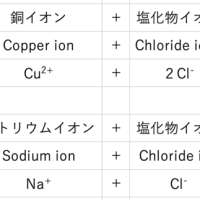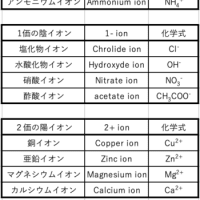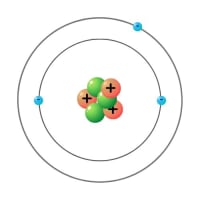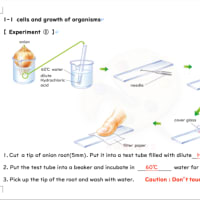単語集
| 変温動物 | cold-blooded animals |
| 恒温動物 | warm-blooded animals |
| 始祖鳥 | Archeopteryx |
| シーラカンス | coelacanth |
| 相同器官 | homologous organs |
| 痕跡器官 | vestigial organs |
| 進化 | evolution |
| ダーウィン | Darwin |
| 脊椎動物 | Vertebrate animals |
| 魚類 | fish |
| 両生類 | amphibians |
| 爬虫類 | reptiles |
| 鳥類 | birds |
| 哺乳類 | mammals |
| 種子植物 | seed plants |
| 被子植物 | angiosperms |
| 裸子植物 | gymnosperms |
| シダ植物 | pteridophytes |
| コケ植物 | bryophytes |
| 古生代 | Paleozoic era |
| 中生代 | Mesozoic era |
| 新生代 | Cenozoic era |
1.脊椎動物の仲間
脊椎動物には魚類・両生類・爬虫類・鳥類・哺乳類がいる。
これらの共通点と相違点を整理すると次の表のようになる。
| 魚類 | 両生類 | 爬虫類 | 鳥類 | 哺乳類 | |
| 背骨がある | ○ | ○ | ○ | ○ | ○ |
| 親が肺で呼吸する | × | ○ | ○ | ○ | ○ |
| 子が陸上で生まれる | × | × | ○ | ○ | ○ |
| 恒温動物である | × | × | × | ○ | ○ |
| 胎生である | × | × | × | × | ○ |
例えば、脊椎動物は恒温動物と変温動物に分けられる。
恒温動物は外気温に関係なく、体温が一定に保たれる。
一方、変温動物は外気温が変化すると体温も変化する。
1.Vertebrate animals
Fish, amphibians, reptiles, birds and mammals are vertebrate animals.
Table below shows similarities and differences of vertebrate animals.
| fish | amphibians | reptiles | birds | mammals | |
| back bone | ○ | ○ | ○ | ○ | ○ |
| adults have lungs | × | ○ | ○ | ○ | ○ |
| born on land | × | × | ○ | ○ | ○ |
| warm-blooded | × | × | × | ○ | ○ |
| born as baby | × | × | × | × | ○ |
For example, vertebrate are divided into cold-blooded and warm-blooded.
Warm-blooded animals can keep their body temperature but cold-blooded animals can not keep their temparature.
脊椎動物の化石は古生代以降の地層から発見されている。
魚類の化石が最初に発見されたのは、古生代初期の地層から発見されている。
次に古生代中期の地層から両生類が、古生代後期の地層からは爬虫類の化石が発見されるようになる。
さらに中生代初期の地層から哺乳類の化石が、中生代中期の地層から鳥類の化石が発見されるようになる。
このように、脊椎動物の5つの仲間は同時に出現したのではなく、魚類、両生類、爬虫類、哺乳類、鳥類の順番に出現したことがわかる。
Vertebrate fossils have been found in strata since the Paleozoic.
Fossils of fishes were first discovered in strata from the early Paleozoic era.
Next, amphibian fossils were found in strata from the Middle Paleozoic, and reptile fossils were found in strata from the Late Paleozoic.
Furthermore, mammalian fossils are found in strata from the early Mesozoic era, and avian fossils are found in strata from the middle Mesozoic era.
Thus, it can be seen that the five vertebrate groups did not appear at the same time, but in the following order: fish, amphibians, reptiles, mammals, and birds.
2.進化の証拠
始祖鳥という脊椎動物の化石が中生代中期の地層から発見されている。
始祖鳥は翼や羽毛のような鳥類の特徴と、歯や爪のような爬虫類の特徴を両方持っている。
また、シーラカンスという魚類の仲間の化石は古生代中期以降の地層から発見されている。
シーラカンスは肉質のひれのなかに太い骨格があり、カエルの前脚と比較すると基本的なつくりが同じである。
このことから、両生類の前脚は魚類の胸びれが変化してできたものだと考えることができる。
Fossils of a vertebrate called Archeopteryx(the primitive bird; the prehistoric bird) have been found in strata from the Middle Mesozoic era.
Archeopteryx has both avian features, such as wings and feathers, and reptilian features, such as teeth and claws.
Fossils of the coelacanth, a member of the fish family, have also been found in strata from the Middle Paleozoic onward.
The coelacanth has a thick skeleton within its fleshy fins, and when compared to the forelegs of frogs, the basic structure of the coelacanth is the same.
This suggests that the amphibian forelegs are the result of a modification of the pectoral fins of fishes.
現在の見かけの形やはたらきが違っても、基本的なつくりが同じで、元は同じものであったと考えられる器官を相同器官という。
また、ヒトの耳を動かす筋肉や、クジラやヘビの後ろ脚の名残りなどはたらきがほとんど失われてしまった器官を痕跡器官という。
Organelles that have the same basic structure and are thought to have been originally the same, even if their current appearance and function are different, are called homologous organs.
Organs that have lost most of their functions, such as the muscles that move the human ear and the remnants of the hind legs of whales and snakes, are called vestigial organs.
長い年月を経て生物の形や性質が変化していくことを進化という。
始祖鳥やシーラカンスの存在、相同器官の存在などが進化の証拠と考えられている。
遺伝子に変化が起きると形質が変化し、進化の原因になる。
The change in the form and properties of an organism over a long period of time is called evolution.
The existence of the primordial bird, the coelacanth, and homologous organs are considered evidence of evolution.
When changes occur in genes, traits change and cause evolution.


















※コメント投稿者のブログIDはブログ作成者のみに通知されます